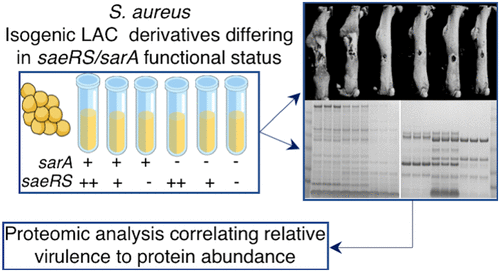当前位置:
X-MOL 学术
›
ACS Infect. Dis.
›
论文详情
Our official English website, www.x-mol.net, welcomes your
feedback! (Note: you will need to create a separate account there.)
Exploiting Correlations between Protein Abundance and the Functional Status of saeRS and sarA To Identify Virulence Factors of Potential Importance in the Pathogenesis of Staphylococcus aureus Osteomyelitis.
ACS Infectious Diseases ( IF 4.0 ) Pub Date : 2019-11-26 , DOI: 10.1021/acsinfecdis.9b00291 Aura M Ramirez 1 , Stephanie D Byrum 2, 3 , Karen E Beenken 1 , Charity Washam 2, 3 , Rick D Edmondson 2 , Samuel G Mackintosh 2 , Horace J Spencer 4 , Alan J Tackett 2, 3 , Mark S Smeltzer 1, 5
ACS Infectious Diseases ( IF 4.0 ) Pub Date : 2019-11-26 , DOI: 10.1021/acsinfecdis.9b00291 Aura M Ramirez 1 , Stephanie D Byrum 2, 3 , Karen E Beenken 1 , Charity Washam 2, 3 , Rick D Edmondson 2 , Samuel G Mackintosh 2 , Horace J Spencer 4 , Alan J Tackett 2, 3 , Mark S Smeltzer 1, 5
Affiliation

|
We used a murine model of postsurgical osteomyelitis (OM) to evaluate the relative virulence of the Staphylococcus aureus strain LAC and five isogenic variants that differ in the functional status of saeRS and sarA relative to each other. LAC and a variant in which saeRS activity is increased (saeC) were comparably virulent to each other, while ΔsaeRS, ΔsarA, ΔsaeRS/ΔsarA, and saeC/ΔsarA mutants were all attenuated to a comparable degree. Phenotypic comparisons including a mass-based proteomics approach that allowed us to assess the number and abundance of full-length proteins suggested that mutation of saeRS attenuates virulence in our OM model owing primarily to the decreased production of S. aureus virulence factors, while mutation of sarA does so owing to protease-mediated degradation of these same virulence factors. This was confirmed by demonstrating that eliminating protease production restored virulence to a greater extent in a LAC sarA mutant than in the isogenic saeRS mutant. Irrespective of the mechanism involved, mutation of saeRS or sarA was shown to result in reduced accumulation of virulence factors of potential importance. Thus, using our proteomics approach we correlated the abundance of specific proteins with virulence in these six strains and identified 14 proteins that were present in a significantly increased amount (log2 ≥ 5.0) in both virulent strains by comparison to all four attenuated strains. We examined biofilm formation and virulence in our OM model using a LAC mutant unable to produce one of these 14 proteins, specifically staphylocoagulase. The results confirmed that mutation of coa limits biofilm formation and, to a lesser extent, virulence in our OM model, although in both cases the limitation was reduced by comparison to the isogenic sarA mutant.
中文翻译:

利用蛋白质丰度与 saeRS 和 sarA 功能状态之间的相关性来识别在金黄色葡萄球菌骨髓炎发病机制中具有潜在重要性的毒力因子。
我们使用术后骨髓炎 (OM) 小鼠模型来评估金黄色葡萄球菌菌株 LAC 和 5 种等基因变体的相对毒力,这些变体的 saeRS 和 sarA 功能状态彼此不同。 LAC 和 saeRS 活性增加的变体 (saeC) 彼此具有相当的毒性,而 ΔsaeRS、ΔsarA、ΔsaeRS/ΔsarA 和 saeC/ΔsarA 突变体均被减弱到相当程度。表型比较包括基于质量的蛋白质组学方法,该方法使我们能够评估全长蛋白质的数量和丰度,这表明 saeRS 的突变减弱了我们 OM 模型中的毒力,这主要是由于金黄色葡萄球菌毒力因子的产生减少,而sarA 这样做是由于蛋白酶介导的这些相同毒力因子的降解。通过证明消除蛋白酶的产生在 LAC sarA 突变体中比在同基因 saeRS 突变体中更大程度地恢复毒力,证实了这一点。不管所涉及的机制如何,saeRS 或 sarA 的突变已被证明会导致潜在重要毒力因子积累的减少。因此,使用我们的蛋白质组学方法,我们将这六种菌株中特定蛋白质的丰度与毒力相关联,并与所有四种减毒菌株相比,鉴定出两种强毒菌株中存在量显着增加的 14 种蛋白质 (log2 ≥ 5.0)。我们使用无法产生这 14 种蛋白质之一(特别是葡萄球菌凝固酶)的 LAC 突变体,在 OM 模型中检查了生物膜形成和毒力。 结果证实,coa 的突变限制了生物膜的形成,并在较小程度上限制了我们 OM 模型中的毒力,尽管与同基因 sarA 突变体相比,在这两种情况下限制都减少了。
更新日期:2019-11-28
中文翻译:

利用蛋白质丰度与 saeRS 和 sarA 功能状态之间的相关性来识别在金黄色葡萄球菌骨髓炎发病机制中具有潜在重要性的毒力因子。
我们使用术后骨髓炎 (OM) 小鼠模型来评估金黄色葡萄球菌菌株 LAC 和 5 种等基因变体的相对毒力,这些变体的 saeRS 和 sarA 功能状态彼此不同。 LAC 和 saeRS 活性增加的变体 (saeC) 彼此具有相当的毒性,而 ΔsaeRS、ΔsarA、ΔsaeRS/ΔsarA 和 saeC/ΔsarA 突变体均被减弱到相当程度。表型比较包括基于质量的蛋白质组学方法,该方法使我们能够评估全长蛋白质的数量和丰度,这表明 saeRS 的突变减弱了我们 OM 模型中的毒力,这主要是由于金黄色葡萄球菌毒力因子的产生减少,而sarA 这样做是由于蛋白酶介导的这些相同毒力因子的降解。通过证明消除蛋白酶的产生在 LAC sarA 突变体中比在同基因 saeRS 突变体中更大程度地恢复毒力,证实了这一点。不管所涉及的机制如何,saeRS 或 sarA 的突变已被证明会导致潜在重要毒力因子积累的减少。因此,使用我们的蛋白质组学方法,我们将这六种菌株中特定蛋白质的丰度与毒力相关联,并与所有四种减毒菌株相比,鉴定出两种强毒菌株中存在量显着增加的 14 种蛋白质 (log2 ≥ 5.0)。我们使用无法产生这 14 种蛋白质之一(特别是葡萄球菌凝固酶)的 LAC 突变体,在 OM 模型中检查了生物膜形成和毒力。 结果证实,coa 的突变限制了生物膜的形成,并在较小程度上限制了我们 OM 模型中的毒力,尽管与同基因 sarA 突变体相比,在这两种情况下限制都减少了。











































 京公网安备 11010802027423号
京公网安备 11010802027423号